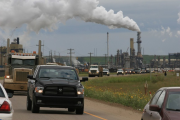Tradition tells us that when our oil and gas industry is experiencing a boom, we feel the benefits right through our economy.
In this sense, it is in every Albertan’s interest that our oil and gas sector remains competitive. Which is why you might have been alarmed to hear some political and industry figures claim in recent weeks that forthcoming federal regulations aimed at capping and cutting sector emissions will be tantamount to a forced production cut that would hurt the industry, and Alberta’s economic outlook.
But look more deeply at the policy and the context, and you’ll find the opposite is true. We are actually talking about preparing our oil and gas sector for the future.
The outlook for fossil fuel production everywhere is changing, as governments are taking their climate commitments seriously. Multiple credible agencies now forecast that the current pace of technology improvement and international climate action will result in demand for oil plateauing and declining by 2030. One example is the rapid decline in the cost of electric vehicles resulting in a swift uplift in people making the switch. According to the International Energy Agency, EVs represented just over two per cent of vehicle sales globally in 2019; by the end of 2021, market share had risen to nine per cent — with early figures for 2022 indicating the trend is set to continue.
As international climate policy action continues to ramp up, global competition amongst oil and gas producers will intensify. In 2030, 2050 and beyond, producers with the best climate credentials are going to be best-placed to compete internationally for the reduced demand. And despite some improvements in emissions per barrel of production in the last decade, Canadian oil production from well to vehicle tank has an emissions intensity of 147 per cent of the global average (second only to Venezuela).
Efforts by the federal government to cap and cut absolute emissions can therefore be seen as a recognition that in the medium long term, to keep up with the ESG demands of investors — and in a context of reduced oil demand overall — producers must decarbonize their operations to stay competitive. In doing so, the industry can not only do its fair share in combating climate change, but also make sure looming financial liabilities of cleaning up disused wells and oilsands tailings ponds do not end up being piled on to Albertans, when producers themselves can no longer meet those costs due to being outcompeted. This is a problem made worse by the provincial government recently taking steps to strip away all requirements for companies to put aside money to clean up tailings ponds.
An irrefutable sign the industry itself recognizes falling oil demand outlooks, is that this is the first major oil price boom that isn’t being accompanied by investment in new production facilities. Despite record revenues the past few years, companies have been focused on paying down debt, buying back shares, and paying dividends to investors. According to the Bank of Canada, capital expenditure as a percentage of cashflow in the oil and gas industry is now at a record low.
Those windfall profits could be wisely invested in decarbonization measures, that would both future-proof the sector for the low-carbon competition of the near future, and satisfy the federal government’s climate wishes. The Pathways Alliance, which represents over 95 per cent of Canada’s oilsands industry, has made big promises on decarbonization, showing they see why it’s important to their industry’s future.
The Pathways plan — which between now and 2030 hinges substantially on its pledge to build carbon-capture facilities in Alberta — received a big boost from Ottawa this year, in a 50-per-cent investment tax credit. This is an important signal from the federal government that, far from unfairly targeting the industry for punishment, it is willing to work with the sector to achieve decarbonization in a way producers themselves have identified as workable and non-damaging to their operations.
The cap is also a reflection of the government’s seriousness when it comes to Canada’s climate promises, in which every industry will need to do its part. Oil and gas production remains our biggest source of emissions, but is only being asked to do its fair share in contributing to the same economy-wide emissions cuts as everyone else.
Our research shows not only that the emissions reductions are achievable, but also that the sector has all the technology and funds it needs to get started right away; all that is missing was increased certainty in the investment environment. The emissions cap should solve that last problem.







